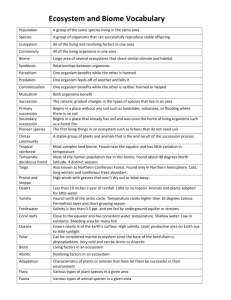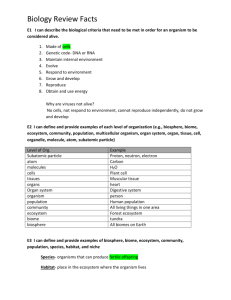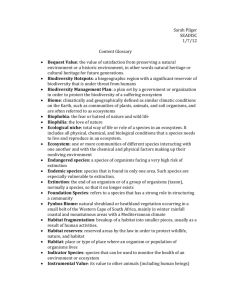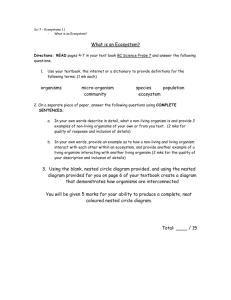Honors Final Review Packet – Complete the following review packet
advertisement
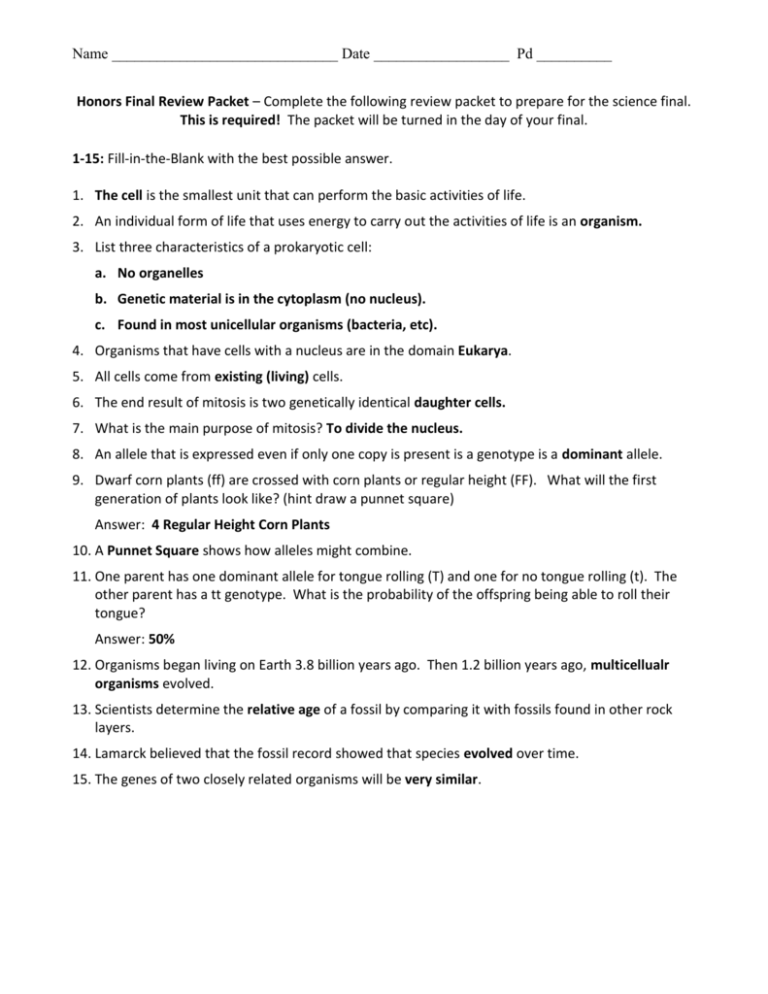
Name ______________________________ Date __________________ Pd __________ Honors Final Review Packet – Complete the following review packet to prepare for the science final. This is required! The packet will be turned in the day of your final. 1-15: Fill-in-the-Blank with the best possible answer. 1. The cell is the smallest unit that can perform the basic activities of life. 2. An individual form of life that uses energy to carry out the activities of life is an organism. 3. List three characteristics of a prokaryotic cell: a. No organelles b. Genetic material is in the cytoplasm (no nucleus). c. Found in most unicellular organisms (bacteria, etc). 4. Organisms that have cells with a nucleus are in the domain Eukarya. 5. All cells come from existing (living) cells. 6. The end result of mitosis is two genetically identical daughter cells. 7. What is the main purpose of mitosis? To divide the nucleus. 8. An allele that is expressed even if only one copy is present is a genotype is a dominant allele. 9. Dwarf corn plants (ff) are crossed with corn plants or regular height (FF). What will the first generation of plants look like? (hint draw a punnet square) Answer: 4 Regular Height Corn Plants 10. A Punnet Square shows how alleles might combine. 11. One parent has one dominant allele for tongue rolling (T) and one for no tongue rolling (t). The other parent has a tt genotype. What is the probability of the offspring being able to roll their tongue? Answer: 50% 12. Organisms began living on Earth 3.8 billion years ago. Then 1.2 billion years ago, multicellualr organisms evolved. 13. Scientists determine the relative age of a fossil by comparing it with fossils found in other rock layers. 14. Lamarck believed that the fossil record showed that species evolved over time. 15. The genes of two closely related organisms will be very similar. Name ______________________________ Date __________________ Pd __________ 16-26: Matching. Match the word to the statement. Write the letter on the line. ___C___ 16. This is the process where the nucleus of the cell divides prior to cytokinesis. A. Grassland ___F___ 17. This occurs when species are separated into isolated groups. B. Frog ___I___ 18. Inherited traits are a result of this. C. Mitosis ___B___ 19. This is an example of a biotic factor in a pond ecosystem. D. Germination ___K___ 20. Both the soil and the trees in a forest are in the same this. E. Glacier retreats ___H___ 21. During photosynthesis, a plant converts this into chemical energy. F. Speciation ___E___ 22. Primary succession occurs after a __________________. G. Pollen ___J___ 23. Sex cells are made during this process. H. Sunlight ___A___ 24. This biome is in the transition zone between deserts and temperate forests. I. Genes ___D___ 25. This is when a seed starts to grow. J. Meiosis ___G___ 26. Bees visit flowers to collect nectar from flowers. They also transport this from flower to flower. K. Ecosystem 27-36: True/False If the statement is true, write true on the line. If the statement is false, change the underlined term to make the statement true. True 27. Variation and adaptation support the theory of natural selection. False-Overproduction 28. Of the several thousand eggs that a pike lays, only several dozen live to adulthood. This is an example of isolation. False-Natural Selection 29. Finches two separate island have different shaped beaks. This is a result of sexual reproduction. True 30. You can find mitochondria and endoplasmic reticulum in animal and plant cells. True 31. Scientists classify jaguars, ocelots, and lynx in the same family based on the animals’ similar physical traits. False-Endocytosis 32. During exocytosis the cell membrane surrounds materials that need to be transported into the cell. False-23 33. A 2n human body cell has 46 chromosomes. A male gamete (sperm) has 32 chromosomes. Name ______________________________ Date __________________ Pd __________ True 34. During sexual reproduction, a gamete from each parent combines to form a new cell. True 35. DNA stores information as genes made up of nucleotides. True 36. Pure nitrogen must be fixed before it can be used by plants. 37-55: Fill in the blank with the best possible answer 37. Ecology is the study of how organisms interact with eachother and their environment. 38. Nonliving parts of an ecosystem include temperature, light, soil, and water. 39. Describe the difference between a food chain and food web. A food chain shows one feeding relationship and a food web shows many interlocking feeding relationships. 40. A producer is an organism that captures energy and stores food as chemical energy. An example of a producer is moss. 41. Both consumers and producers are a source of food for decomposers. 42. Label the following energy pyramid with what level has the most energy and what level has the least amount of energy. 43. Put the following terms in correct order from simplest to most complex: Ecosystem, Community, Biome, Organism, Population Organism, Population, Community, Ecosystem, Biome 44. Interactions that benefit one species and does not benefit or harm the other species is commensalism. Name ______________________________ Date __________________ Pd __________ 45. Grazing in a herd benefits a buffalo population because it gives them increased protection from predators. 46. Each species has a different role, or niche, in an ecosystem. 47. Competition is the struggle between individuals or different populations for a limited resource. An example of competition is Creosote bushes release chemicals into soil to prevent other plants from putting out roots. 48. The biome that receives the most rain fall each year is the tropical forest. 49. A gradual change in an area’s community is called succession. 50. Explain the term carrying capacity. The maximum number of individuals that an ecosystem can support. 51. Define natural resource. Any type of material or energy that humans use to meet their needs. 52. Would the population density be greater in a city or suburbs? Why? Population density is greater in a city than in suburbs because there are more people in a smaller place. 53. Name 3 renewable resources. Trees, Sunlight, Water 54. Name 3 nonrenewable resources. Oil, Coal, Petroleum 55. Define conservation. The process of saving or protecting a natural resource. Describe sustainable practices. Ways of living and doing business that use natural resources without using them up. (i.e. Developing new technologies, reducing resource use, and creating less waste)


